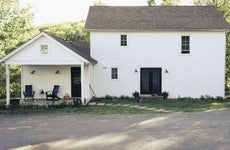
The Bankrate promise
At Bankrate, we strive to help you make smarter financial decisions. To help readers understand how insurance affects their finances, we have licensed insurance professionals on staff who have spent a combined 47 years in the auto, home and life insurance industries. While we adhere to strict , this post may contain references to products from our partners. Here's an explanation of . Our content is backed by Coverage.com, LLC, a licensed entity (NPN: 19966249). For more information, please see our .
Key takeaways
- HO-3 insurance is the most common type of home insurance policy.
- Standard HO-3 policies provide coverage for your home's structure, contents, liability, medical payments and additional living expenses.
- Standard HO-3 policies exclude damage from flooding and earthquakes, but coverage may be available through endorsements or standalone policies.
A house is more than just the place where you live. There is an emotional connection to a house that makes it a home: it’s a place where you have invested your time, effort and money to make it safe and comfortable for you and your family. To financially protect this investment, most experts recommend purchasing homeowners insurance. HO-3 coverage is the most common type of home insurance, but it’s not the right fit for every home and situation. Find out if HO-3 coverage is right for you and how you can build an effective policy for your home and family.
What is HO-3 insurance?
HO-3 insurance is the most common type of home insurance and is available through almost every private property insurance company. At a high level, it provides insurance coverage for your home, your personal belongings and your liability as a homeowner. HO-3 insurance policies are primarily available for single-family homes; however, some multi-family homes and townhouses may need this type of coverage in some cases. One primary qualification for an HO-3 policy is owning and residing in the dwelling and needing to ensure the entire structure of the home.
While HO-3 policies cover your home and belongings, homeowners should be aware of the difference in how they are covered. Your home and structures fall under ‘open perils’ or ‘all risk’ coverage.’ Open perils provide coverage for any disaster unless otherwise excluded in your policy. Your belongings, however, fall under ‘named perils.’ Named perils only offer coverage for the losses listed, or named in your policy.
HO-3 insurance at a glance
| Ideal for | Homeowners who need to cover the entire structure of their home |
|---|---|
| Covers | Structure of your home, other structures, personal belongings, loss of use expenses and personal liability as a homeowner |
| Cost | Average cost of an HO-3 policy with $250K in dwelling coverage is $1,428 per year |
| May not be right for | Condos, townhouses, landlords, vacant homes, renters |
What does an HO-3 policy cover?
Typically, HO-3 insurance policies contain six coverage types common among most homeowners insurance policy forms. For dwelling and other structures coverage, claims are paid at replacement cost value up to the policy’s limits — meaning depreciation is not a factor in your claims payout after a loss. Also, the amount of coverage for many types is based on a certain percentage of the dwelling coverage. For example, if a dwelling is insured for $200,000, the other structures coverage is usually covered up to $20,000 or 10 percent of the dwelling coverage.
The predetermined coverage amount can vary between insurance providers, and optional endorsements are available to increase the coverage limits. Coverage types provided in an HO-3 policy are as follows:
- Dwelling coverage: Dwelling coverage covers repairs for your home’s structure and any attached structures, like a porch or garage. Insurance agents can determine your home’s insurable value with the help of a replacement cost calculator when you set up your homeowners insurance policy.
- Other structures coverage: Any detached structures, like detached garages, driveways, sheds and fences, are typically covered under other structures coverage. The typical coverage limit is 10 percent of the dwelling coverage, but you may be able to adjust your coverage depending on your insurance carrier.
- Personal property coverage: Personal property coverage helps cover costs for your personal items, like clothing and furniture, damaged from covered perils. The coverage limit for personal property is usually between 50 and 70 percent of the dwelling coverage.
- Liability coverage: Personal liability coverage provides financial protection if you or a household family member are found negligent for bodily injury or property damage caused to others. Most claims are due to losses incurred on the insured property, but there are situations where the liability coverage can extend past your home’s premises.
- Medical payments coverage: Medical payments coverage will help pay for a guest’s medical expenses if they get injured at your home. The homeowner does not need to be negligent to utilize medical payments coverage.
- Additional living expenses: Additional living expenses help pay for your hotel, food, laundry and parking expenses if a covered peril damages your home and you have to relocate temporarily. The limit for this coverage is usually between 20-30 percent.
Remember that HO-3 insurance covers your personal property on a named-perils basis, which means your personal items are only covered from a list of specific perils that are written in your policy. There are typically 16 named perils, which include these more-common perils:
- Fire
- Windstorms
- Accidental water damage
- Theft
- Weight from ice and snow
- Vandalism
- Explosions
- Freezing pipes
Another thing to know about personal property coverage is that it typically pays out claims after factoring in depreciation which is actual cash value or AVC, not replacement cost. If you are interested in replacement cost value or RCV for your personal belongings, such as clothing, furniture and appliances, talk to your agent about adding a personal property replacement cost endorsement to your HO-3 policy. This is an optional coverage available with most insurance companies and adds about 10 percent more to the policy premium.
HO-3 policy exclusions
Despite the fact that HO-3 insurance covers your home on an open-perils basis, it does not cover everything. In fact, some common exclusions are:
- Earthquakes
- Floods
- Sinkholes
- Sewer backup
- Government intervention
- Wear and tear
- Damage due to lack of maintenance
- Rodent or pest infestation
- Rust, mold and corrosion
- Damage from pets
Depending on where you live, it’s a good idea to purchase additional coverage to supplement your HO-3 policy. For instance, if you live in California, consider purchasing earthquake insurance. If you live in an area that is prone to hurricanes, like Florida or Louisiana, having flood insurance can save you a lot of out-of-pocket costs.
Who needs HO-3 coverage?
HO-3 insurance policies are ideal for the average homeowner with a dwelling type that qualifies for the policy. The vast majority of U.S. homeowners have this type of insurance. You can usually add endorsement policies to your HO-3 insurance if you need coverage above and beyond the policy limits.
However, there are other types of home insurance. If you live in a new home, somewhere that has a low risk of natural disasters and crime, you might qualify for an HO-5 policy. If you live in an older home, especially one that is historic or architecturally significant, you can purchase an HO-8 policy. Both HO-5 and HO-8 insurance policies provide more coverage than HO-3 policies.
What other types of home insurance are there?
Just like there is more than one type of home, there is more than one kind of home insurance policy. Each home insurance policy offers different coverage types:
- HO-1: This is the most basic home insurance policy and is usually offered to older homes that are at high risk for an insurance claim. Coverage is limited to the structure of the home, attached structures, appliances and permanently installed items like carpets. The HO-1 policy pays claims on a named-perils basis.
- HO-2: Everything included in the HO-1 is offered on the HO-2, with limited liability protection. Detached structures, personal property and loss of use are also covered. This policy type is also a named-perils policy.
- HO-4: This policy type is for renters, providing contents coverage and liability protection. Additional living expenses and guest medical payments may also be offered. There is no structure coverage, and this is also a named-perils policy.
- HO-5: The HO-5 is similar to an HO-3, but covers your home and personal property on an open-perils basis. It also sometimes includes extra coverage for expensive items like jewelry. The HO-5 is typically offered to those in high-value homes.
- HO-6: The HO-6 is usually for condo unit owners and some townhome owners and covers from the studs into the unit. A separate HOA master policy covers the home’s exterior. Besides the limitations on the structure, it functions much like an HO-3 policy.
- HO-7: Mobile, modular and manufactured homes are covered by the HO-7 policy. Coverage is similar to an HO-3, but the structure is covered under an open-perils basis, while contents are insured under a named-perils basis.
- HO-8: This policy type is typically reserved for historic or architecturally significant homes that are difficult or impossible to replace. Standard coverage types apply like the HO-3 and claims are paid on a named-perils basis.
HO-3 vs. HO-4 policies
When it comes to HO-3 vs. HO-4 policies, the difference is straightforward. An HO-3 policy is a typical homeowners policy, while the HO-4 is a renters policy.
An HO-4 policy protects a renter’s possessions and provides liability coverage. Sometimes, it also includes coverage for additional living expenses. If a renter must relocate while their home is being repaired due to a covered loss, additional living expense coverage can help them pay for a hotel or temporary rental. HO-4 insurance does not cover the structure of the building you rent. Instead, the landlord covers the structure through a policy of their own.
HO-3 vs. HO-5 policies
HO-3 vs. HO-5 policies is an easier comparison, since they are both homeowners policies. An easy way to keep these policies straight is that the HO-5 policy is like an upgraded version of the HO-3. An HO-5 policy provides open-perils coverage for both your structure and your possessions. An HO-3, on the other hand, still covers your structure under open perils but gives named-perils coverage for your possessions. Additionally, an HO-5 policy can offer additional coverage for expensive items like jewelry, but not always.
In other words, there are more coverage restrictions on your possessions under an HO-3. This usually makes an HO-3 policy cheaper than an HO-5 policy.
Frequently asked questions
-
-
HO-3 insurance includes all of the standard home insurance coverage types, including dwelling, personal property, other structures, liability, medical payments and additional living expenses coverage. HO-3 policies cover the physical structure of your home on an open-perils basis, while your personal belongings are covered on a named-perils basis.
-
You can purchase HO-3 policies online, over the phone, via app or in person with most national or local insurance companies and agents. Not all national companies have availability in every state, and states with a high risk of widespread loss from perils like floods, wildfires and earthquakes may have a more challenging time finding homeowners coverage at an affordable price. If you fall into this category, consider speaking with an auto insurance broker to see if they know a company offering coverage for your home in your area.
-
The cost of HO-3 insurance is different for everyone. Some factors that contribute to the premium of your HO-3 policy are the location, square footage, age of the home, age of the roof, and cost of building materials, just to name a few. These factors relate to the property, but you, the homeowner, also play a part. Depending on the state and insurance provider, credit history, claims history and even household pets, and many other factors, may impact the rate of your home insurance premium. Because of these factors, shopping around and comparing home insurance quotes is an excellent way to see which provider can give you the best price.
-
The best home insurance company for an HO-3 policy will depend on a number of factors, including the amount of coverage that you need, where your home is located, the type of customer service you want and your budget. Fortunately, nearly all home insurance companies offer HO-3 policies. If you’re looking for a place to start, Bankrate’s insurance editorial team identified USAA, Allstate, Lemonade and Chubb as some of the best home insurance companies, but comparing rates and coverage options will help you narrow down the top provider for your coverage needs.
-
Related Articles

How to choose the right, cheap home insurance for your budget


